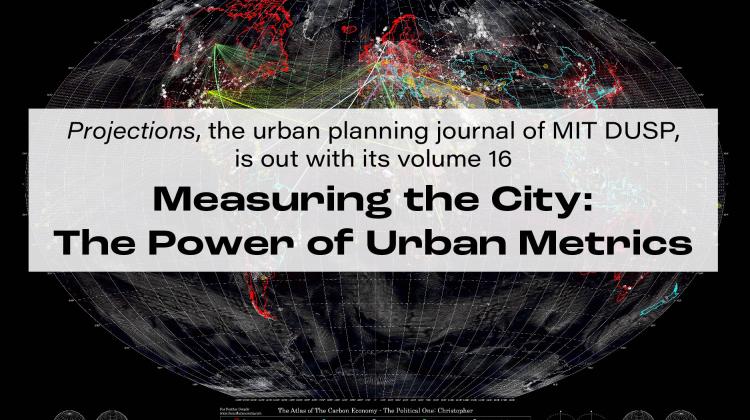Measuring the City: The Power of Urban Metrics

The rising tide of urban data is transforming the field of urban planning. Studies utilizing cell phone data, social network service data, sensors, and satellite imageries have opened up new avenues of inquiry to quantify the built environment and model formerly hidden human mobility dimensions. Despite the myriad ways to synthesize this newly available information, the act of shaping cities remains a political gesture often legitimized through the use of data. The most recent volume of Projections, “Measuring the City: The Power of Urban Metrics”, shares critical reflections and nuanced and situated practices of urban models that can hopefully inform and transform cities.
Projections, the open-access journal of DUSP, is published by the MIT Press and showcases innovative research in the field of urban studies and planning. Each volume of Projections focuses on a different topic engaging scholars, students, and professionals.
The Projections Vol. 16 is edited by Chaewon Ahn, Carmelo Ignaccolo, and Arianna Salazar Miranda, and brings together papers that reflect on the advantages and pitfalls of using spatial data to study cities. The issue includes the work of scholars studying political structures and how they relate to the built environment using novel datasets and methodologies, and others who study the politics of urban design and policy using urban data. More specifically, this volume aims to 1) critically evaluate the nature of the urban data that is ceaselessly generated; 2) investigate how the understanding of city life is being fundamentally reshaped through data-driven models and measurements; and 3) demonstrate how these models interface with real-world politics of urban design in cities.
“With this volume, we wanted to create a shared outlet for those who develop data-heavy urban models, and those who study the epistemology and situatedness of such models. We are excited to share papers from various parts of the world, using diverse methods, with different vantage points towards urban data, models, and politics,” said Ahn.
Articles in this volume include:
Three papers that engage with various urban data and modeling techniques but pay particular attention to contextual and behavioral nuances. "From exceptional architecture to city icons? Analyzing data scraped from Flickr" by Nadia Alaily-Mattar, Lukas Vordemann, Diane Arvanitakis, Alain Thierstein, "Do you live in a bubble? Designing critical metrics to intervene in the cartography of urban diversity" by Anders Koed Madsen, and “Parallel Worlds: Revealing the Inequity of Access to Urban Spaces in Mexico City Through Mobility Data” by Emmanuel Letouzé, Zinnya del Villar, Rodrigo Lara Molina, Berenice Fernandez Nieto, Guillermo Romero, Julie Ricard, Diego Vazquez, and Laura Arely Centeno Maya introduce novel approaches to broaden our understanding about architectural symbolism, political diversity and access to public space across different income groups through mining social media and mobility data.
Two papers tackle the limitations of data availability across different geographical contexts. “Scrutinizing the buzzwords in the mobility transition: The 15-minute-city, the one-hour metropolis, and the vicious cycle of car dependency” by Christian Gerten and Stefan Fina, and “Urban MorphoMetrics + Earth Observation: An integrated approach to rich/extra-large-scale taxonomies of urban form” by Sergio Porta, Alessandro Venerandi, Alessandra Feliciotti, Shibu Raman, Ombretta Romice, Jiong Wang, and Monika Kuffer develop novel approaches to measure urban form across different contexts.
Two papers warn against the pitfalls of urban metrics. "Failure to innovate: Urban technocracy and the making and unmaking of Sidewalk Labs Labs smart city" by Justin Collar and "Politics of Open Land Data: The Case of Delhi's Land Pooling Policy" by Sumedha Jain, Benjamin John, and Abhik Banerji examine the politics of data-driven master plans and policies through a historical and ethnographic lens. Collectively, the papers show the breadth of work in the scholarship on data and cities.
“The papers in this volume of Projections show how new large-scale data can benefit from qualitative methods, such as interviews and field observations, to inform our understanding of the context in a nuanced way and guide the interpretation of results,” said Salazar Miranda and Ignaccolo. “The act of zooming out of the models and delving into the consequences of urban metrics makes it clear that technology needs to be used as a means, not an end, and that more transparency in and around data-driven policies is necessary”.


